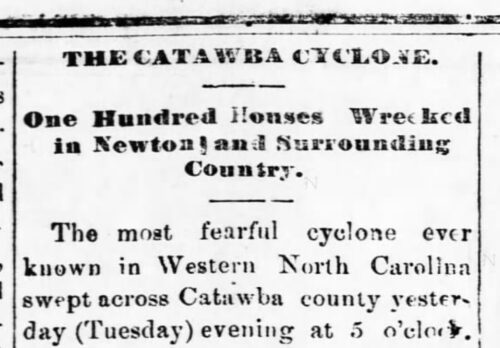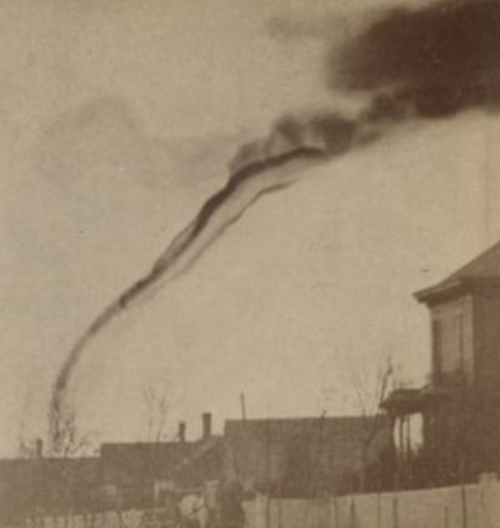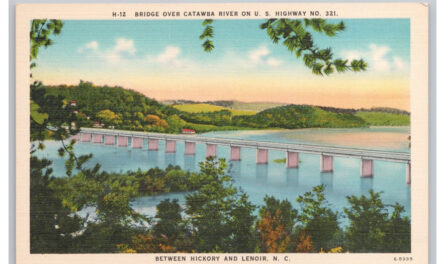
It was a late March day. Everyone anticipated spring, hoping winter was over. Trees and plants greening up all over the place, the calendar (thanks to the vernal equinox) signaled more daylight ahead. Already folks suffered from the weather that year. Heavy rain in late February did harsh damage to the wheat crop. Stories of storms filled the paper as March 1884 both went in and came out like a lion.

Headline from the Carolina Mountaineer informing readers of one of the worst natural disasters to hit Catawba County.
Tuesday afternoon, March 25 in Newton, winds picked up, skies darkened. About 5:00pm, it hit. A few miles southwest of town, three white clouds converged, creating a “funnel-shaped column of vapor (that) reached from the clouds to the ground.” The whirlwind started on a path between the Courthouse on the Square and Catawba College, which was then located on the south end of town. Today, we could call the weather event that struck Newton a tornado, but in 1884 they knew it as a cyclone. Whatever the name, it swept through, “gathering strength as it went.”
For those who witnessed the destruction, they had a tale to tell for the rest of their lives. The cyclone lifted the Methodist Church off its foundation. The building remained intact in the air for about twelve feet, and then was “literally blown into splinters,” recalled a person who saw it. Grave stones were shattered, trees lifted up by the roots and swirled around, and the roof of one Catawba College building was found two miles away. “Flying timbers were driven through the walls of houses, men and animals were hurled across the streets and fields by the force of the storm,” read a report of catastrophic event, labeled “the most fearful cyclone ever known in Western North Carolina.

This image is thought to have been the first photograph of a cyclone. It was taken in 1884, the same year as the Newton cyclone, in Kansas.
With all the debris flying around, including heavy hearthstones found 50 yards from falling chimneys where they once rested, only one death was reported, about six miles from town. A timber from a collapsing house hit a woman in the head, killing her instantly. A child, burned in a fire sparked by lightning was originally reported dead, but survived. Thirty hogs were swept away from one farm, all killed including one found in a tree, thirty feet above the ground. In the immediate aftermath of the storm one eyewitness measured fallen hail at “six inches in circumference.” Later accounts reduced its size to that of a hen’s egg. Everyone agreed though that the sound of the cyclone was like a dull roar. It took less than a minute for it to crash through the walls of each house it visited.
The storm continued taking out everything in its 100-yard wide trek as it headed toward Iredell County. By the time it crossed the Catawba River most of the funnel cloud’s fury had dissipated. That same day, cyclones hit elsewhere including Charlotte, South Carolina and the Ohio Valley, but the concentrated damage seen in Newton was significant. Early reports claimed 100 houses were destroyed. After inspection, the number came to about 40. The African-American community of Snow Hill suffered the worst harm. Two women had to be rescued from underneath a fallen house, “with considerable difficulty.” Many people were displaced with no idea of where they would stay or how they would eat in the aftermath.
By early April, rebuilding had started, including the congregation of the Methodist Church, who met temporarily in the Presbyterian sanctuary. One paper even tried to inject some levity into the tragic event with a riddle, asking “why is a cyclone like the month of March! – Because it is a ‘blower’.” Humor from 138 years ago.









